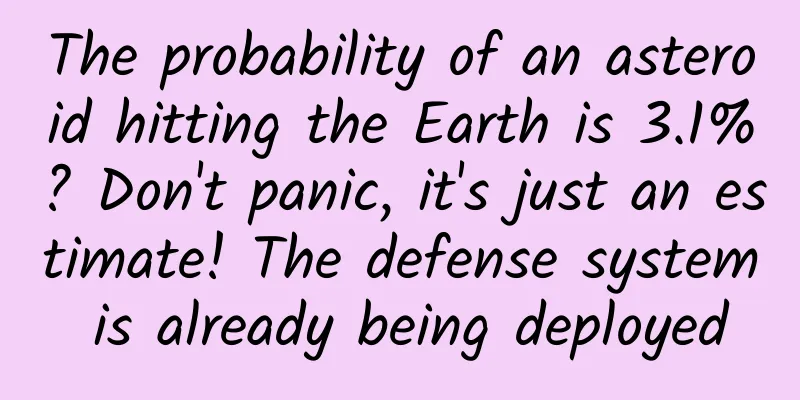The probability of an asteroid hitting the Earth is 3.1%? Don't panic, it's just an estimate! The defense system is already being deployed

|
Recently, the topic that an asteroid numbered "2024 YR4" "may hit the Earth in 7 years" has caused heated discussion on the Internet. Chinese astronomical experts said that the current impact probability is only an estimate, and what is more important now is to carry out continuous observation and orbit calculation. Even if it poses a clear threat to humans in the future, there are many defense strategies. China has begun to deploy a "near-Earth asteroid defense system", and scientists around the world are also collaborating on "planetary defense" as a link. An asteroid hit the earth . Who is this "alien"? "2024 YR4" was first discovered on December 27, 2024. It is estimated that the asteroid is 40 to 90 meters in diameter, about the size of a building, and its potential destructive power comes more from speed than size. If it hits the Earth, the speed may be close to 40,000 miles per hour (about 64,000 kilometers). The most likely scenario is that it will explode in the air after entering the atmosphere, with an energy explosion equivalent to about 7.7 million tons of trinitrotoluene (TNT), enough to destroy a city. ▲Asteroid "2024 YR4" Image source: CNN However, 2024 YR4 is a far cry from being a planet killer asteroid, a category of space rocks with a diameter of 1 kilometer or more that could be devastating to life. The asteroid that wiped out the dinosaurs is estimated to have been about 10 kilometers in diameter. Since early January 2025, astronomers from the National Aeronautics and Space Administration (NASA) have been using telescopes to track the asteroid. Currently, the asteroid is more than 48 million kilometers from Earth. After the discovery of the "2024 YR4" asteroid, experts initially estimated the probability of impact to be 1%. Later, this probability showed a dynamic upward trend. The latest calculation results released by NASA on February 18 showed that the asteroid now has a 3.1% chance of hitting the Earth on December 22, 2032, making it the most threatening space rock in the modern prediction record. "The reason why the predicted probability changes is that the calculation method of the probability of an asteroid hitting the Earth is affected by factors such as orbital calculation errors, lighting and the gravity of large celestial bodies," said Cao Lin, an astronomical science expert. "This is similar to weather forecasting. The closer the time is, the more accurate the prediction will be." ▲The Purple Mountain Observatory of the Chinese Academy of Sciences conducted the 11th successful early warning of an asteroid impact in Yao'an, Yunnan. The picture shows the observation image. Image source: CCTV News There are more than 2,000 known asteroids that pose a threat to Earth. How is an asteroid defined? NASA defines it as: the lower limit is 1 meter in diameter, and some believe it is 10 meters in diameter. Why is it defined as 10 meters? Jiao Weixin, a professor at the School of Earth and Space Sciences of Peking University, explained that asteroids with a diameter of more than 10 meters will not burn up when they enter the Earth's atmosphere, and at least some meteoroids will fall on the Earth's surface. ▲At 7:23 on December 23, 2020, a "fire meteor" streaked across the sky at the junction of Yushu, Qinghai and Qamdo, Tibet, and then landed on the ground. Image source: CCTV News Asteroids can be divided into three types according to their location: near-Earth asteroids orbiting near the Earth, main-belt asteroids distributed between Mars and Jupiter, and Trojan asteroids. Jiao Weixin said that as near-Earth asteroids, those that meet the requirement of perihelion (the closest distance between the Earth and the Sun) being less than 1.3AU (AU is an astronomical unit, the average distance between the Earth and the Sun is set at 1AU, which is approximately equal to 149.6 million kilometers) are near-Earth asteroids. Near-Earth asteroids are divided into Amor asteroids, Apollo asteroids, Atan asteroids and Attila asteroids according to their different locations. As the performance of ground-based telescopes improves, asteroids several meters in size can now be seen. As of 2021, scientists have discovered 27,000 near-Earth asteroids. Scientists use the symbol PHA to represent asteroids that pose a potential threat to the Earth. As of February 2, 2021, scientists have discovered a total of 2,216 PHAs, which means that we know of more than 2,000 asteroids that pose a potential threat to the Earth. As asteroid exploration continues to deepen, this number continues to grow. In November 2023, the Mozi Sky Survey Telescope discovered two new near-Earth asteroids - 2023 WX1 and 2023 WB2. Among them, 2023 WX1 has a minimum orbital rendezvous distance with the Earth of 0.0416 astronomical units, and its estimated diameter is about 170 meters. It is a potentially threatening asteroid (PHA). Will these more than 2,000 asteroids definitely hit the Earth? Not necessarily. "We are just saying that these celestial bodies are more dangerous to hit the Earth. In addition, because asteroids are too small, their orbits are easily affected by large celestial bodies. Scientists predict that there will be no disaster to the Earth, but after being affected by other celestial bodies, they may get closer and closer. Some of them now seem to pose a potential threat to the Earth, but due to other factors, they are getting farther and farther away from us, so this data is developing dynamically," Jiao Weixin explained. Asteroid impacts on Earth are not groundless "The possibility of an asteroid hitting the Earth is not groundless," said Jiao Weixin. On February 15, 2013, an asteroid hit Chelyabinsk, Russia. When the asteroid entered the atmosphere, it left a 10-kilometer-long trail in the sky. The main fragments of the asteroid hit Lake Chebarkul. 1,491 people were injured in the incident. The Earth has experienced catastrophes throughout history, and nearly 200 meteorite craters have been confirmed. Some craters are no longer recognizable due to changes in the Earth and river courses. For example, the Tunguska explosion occurred at 7:17 am on June 30, 1908 over what is now Siberia, Russia. The explosion was estimated to be equivalent to 20 million tons of TNT, and all 80 million trees within 2,150 square kilometers were burned and fell. Jiao Weixin said that the current consensus is that an asteroid with a diameter of about 60 to 190 meters exploded about 6 to 10 kilometers above the ground due to intense friction in the atmosphere and uneven heating, thus leading to the destruction of the entire Tunguska forest. He said that the danger of asteroids hitting the Earth still exists, mainly for three reasons: First, a large number of celestial bodies have not yet been discovered. The number we have observed is only about 10%. There are still many celestial bodies that have not been discovered, and we don’t know whether these celestial bodies are dangerous to hit the Earth. In mid-August 2020, a near-Earth asteroid the size of an SUV, numbered "2020 QG", passed by the Earth at a close distance. Just as it was about to leave, it was detected by NASA's probe, but this was 6 hours later. The second reason is the sudden arrival of uninvited guests, including short-period comets that accidentally enter the inner solar system, making it even more difficult for humans to determine their orbits. For example, Comet Shoemaker-Levy 9 broke into 21 small fragments on July 8, 1994 due to the strong gravity of Jupiter, and hit Jupiter's southern hemisphere at a speed of 210,000 kilometers per hour on July 16, 1994. Fragment G is the most powerful, reaching 6 megatons of TNT, and its equivalent The "scar" caused is expected to be larger than the diameter of the earth. The impact of Comet Shoemaker-Levy 9 on Jupiter highlights the role of Jupiter as a "space vacuum cleaner" in the solar system. Its strong gravity can suck up many comets and asteroids, and the probability of a comet impact on Jupiter is 2,000 to 8,000 times that of the Earth. The Earth is in a very advantageous position, and with the protection of Jupiter, the Earth is a habitable planet. The third reason is the Yakovsky effect, which is when an asteroid absorbs sunlight and releases heat, it will produce a small push on the asteroid. For example, according to observations of the asteroid 6489 Golevka, its position moved 15 kilometers more than expected between 1991 and 2003. A variety of methods can eliminate the threat of asteroids What is the risk of an asteroid hitting the Earth? "The smaller ones are more numerous, so the probability is higher," Jiao Weixin said. According to statistical laws, if the diameter is less than 30 meters, it will break up in the upper atmosphere and generally will not cause casualties on the ground. If the diameter is greater than 30 meters and less than 100 meters, such a celestial body will burn and break up in the lower atmosphere, which will have a local impact on the ground. Asteroids with a diameter greater than 100 meters and less than 300 meters can directly hit the surface of the Earth, producing craters with a diameter of several kilometers. The resulting dust will affect an area with a diameter of 10 kilometers. Asteroids with a diameter greater than 300 meters and less than 600 meters will cause the smallest level of global disaster, causing the deaths of about 500,000 people, with an interval of 25,000 years. An asteroid with a diameter greater than 600 meters and less than 1,000 meters will cause a moderate global disaster, with a death toll of about 5 million and a time interval of 70,000 years. Asteroids with a diameter greater than 1 km and less than 5 km are large enough to cause global damage, killing more than 1 billion people, and occur approximately once every few million years. Jiao Weixin said that there are ten major measures for humans to avoid asteroid impacts. The first is to strengthen observation and early prediction to understand its orbit. The second is to use dynamic impact to deflect the orbit. The third is to install rockets to change the orbit. The fourth is solar sail propulsion. The fifth is gravity tractor. The sixth is nuclear explosion near the asteroid. The seventh is nuclear explosion inside the asteroid. The eighth is mass projector. The ninth is laser ablation. The tenth is to use solar energy to vaporize matter to generate thrust. Among them, the plan of launching a probe for dynamic impact has already been implemented. In November 2021, the United States launched two satellites DART to relatively nearby celestial bodies, impacting a large asteroid with a diameter of about 780 meters and a "small satellite" with a diameter of 160 meters. In addition, as early as January 1996, the United States launched the "Near-Earth Asteroid Dating" probe. During the flight to the asteroid, the probe sent back 160,000 photos and a large amount of precious materials to the Earth, providing scientists with many important references for future exploration of other asteroids and comets. After flying over a distance of 3.2 billion kilometers, the probe successfully entered the orbit of the "Eros" asteroid. On February 12, 2001, the probe successfully landed on the "Eros" asteroid, realizing the first encounter between a probe and an asteroid in history. In 2014, Japan launched the asteroid probe Hayabusa 2, which used a contact-and-leave method to collect asteroid samples and return them to Earth. China begins deploying a near-Earth asteroid defense system In 2023, Wu Yanhua, deputy director of the China National Space Administration, revealed that China must first improve the establishment of ground-based and space-based asteroid monitoring and early warning systems. It is not only necessary to catalog them, but the key is to analyze and determine which ones are critical; it is also necessary to conduct technical research and tackle key problems on whether it is possible to eliminate these threats. While improving its asteroid detection capabilities, China will also start to build a near-Earth asteroid defense system. Wu Yanhua revealed that China will strive to conduct a close observation of a threatening asteroid at the end of the 14th Five-Year Plan or in 2025 or 2026, conduct a nearby impact, and conduct technical experiments on changing its orbit, so as to make new contributions to China's response to the threat of asteroids and other extraterrestrial bodies to the Earth's home in the future. On October 22, 2023, Wu Weiren, director and chief scientist of China's Deep Space Exploration Laboratory and academician of the Chinese Academy of Engineering, stated at the annual meeting of the China Association for Science and Technology that China will launch its first "near-Earth asteroid defense mission" in the next 10 years, and plans to use the "escort + kinetic impact + escort" mode. When the impactor implements a kinetic impact on the target asteroid, the probe will observe the entire impact process and continue to carry out impact effect assessment and scientific exploration after the impact, achieving "kinetic impact + space-based assessment" through a single mission. The specific approach is: aim at a small celestial body tens of meters in size and tens of millions of kilometers away from the Earth, then launch an impactor 10 million kilometers away from it to change its orbit, and then evaluate the effect. The purpose of this mission is to verify the ability to prevent asteroids from hitting the Earth and achieve the goal of "accurately hitting, pushing, measuring, and explaining". Recently, the Major Project Engineering Center of the State Administration of Science, Technology and Industry for National Defense issued a recruitment notice, publicly recruiting three "planetary defense post" employees. It is understood that the tasks of the "planetary defense post" employees are mainly to monitor and warn of near-Earth asteroids. Source: People's Daily Online, CCTV.com, China Science Daily, Science Popularization Central Kitchen, Qilu Evening News, Science and Technology Daily |
<<: We boiled 30 eggs in one go so you can peel the perfect egg
Recommend
The "tornado" of online medicine purchases cannot blow away Dingdang Express Medicine
As control measures were relaxed, the number of p...
Are strawberries really the dirtiest fruit? Can we still eat them without worry?
Netizen question: It is strawberry season recentl...
The mortality rate is extremely high! This bacteria can "eat meat", so be careful in summer!
Produced by: Science Popularization China Author:...
Comprehensive plan for Tik Tok short video marketing and promotion in 2019!
Follow the official account " Operation Uncl...
High repurchase fan community operation strategy
Among the three major categories of communities, ...
A universal copywriting formula for creativity: Creativity = Copying + Transformation + Combination
Remember I said before: Creativity is something t...
Practical “mine-clearing” techniques for event planning!
Some time ago, I often reviewed plans with novice...
How should novice webmasters optimize corporate websites?
"How do we optimize the corporate website?&q...
How can real estate and home furnishing companies attract customers to their stores?
This issue will combine the novel marketing model...
How much does it cost to develop a homestay mini app in Mudanjiang?
The launch of mini programs has brought convenien...
When will the 2022 Beijing Winter Olympics and Paralympics Summary and Commendation Conference be held? Where exactly will it be held? Live streaming platform included!
The 2022 Beijing Winter Olympics and Paralympics h...
Leling SEO Training: How does SEO solve the problem of website retention rate? What are some good ways?
With the continuous development trend of the Inte...
The latest regulations on holidays on March 8, 2022: Is it necessary to have a holiday on Women’s Day? Attached is the latest national holiday arrangements!
There are many holidays in our country, almost on...
4 core basic skills that marketers must know!
Marketing insights: Marketing is a means of satis...
Capybara! Why are there always so many small animals around capybaras?
If life is a game, then friends are the most spec...









